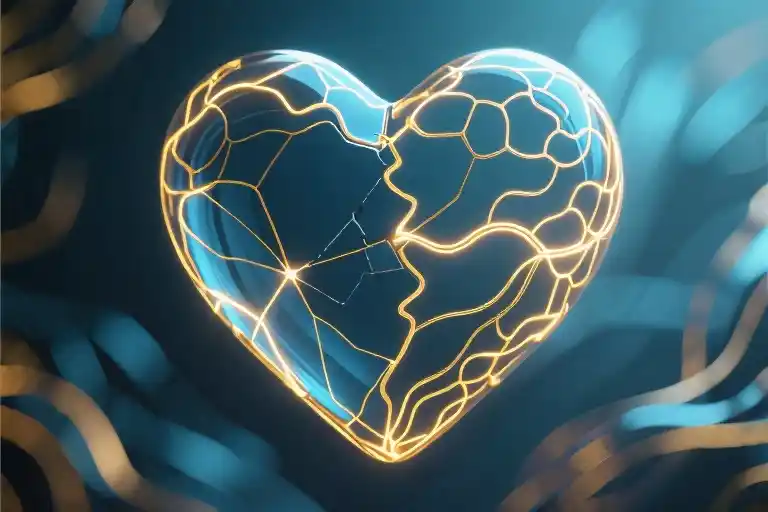The gas station speakers were blaring our song when it hit me—today would have been our seventh anniversary. My hands froze on the gas pump as the opening chords sliced through me like a physical wound. Three months post-divorce, and there I was, a grown woman sobbing over spilled unleaded, my car door wide open as other customers politely pretended not to notice.
This wasn’t an isolated meltdown. When my marriage collapsed, I developed what I can only describe as withdrawal symptoms—except my drug of choice had been love. The parallels were unnerving:
- Cravings: Physically aching to text him at 2AM despite knowing better
- Triggers: Breaking into sweats when passing our favorite sushi place
- Relapses: Weeks of progress undone by finding his stray sock in the laundry room
- Obsession: Analyzing old photos like a detective searching for clues
- Withdrawal: Night sweats, nausea, and shaking hands during no-contact periods
- Rebound: Swiping through dating apps with the desperation of an addict seeking a fix
What shocked me most wasn’t the intensity of these reactions, but how biologically familiar they felt. The trembling hands mirrored my college roommate’s caffeine detox. The mood swings recalled a friend quitting antidepressants. Yet when I mentioned this to my therapist, she nodded knowingly: “Your brain isn’t being dramatic—it’s literally going through chemical withdrawal.”
Neuroscientists now understand that romantic rejection activates the same brain regions as physical pain and substance addiction. A 2011 fMRI study by Fisher et al. found that heartbroken participants shown ex-partners’ photos had dopamine-rich reward centers lighting up like those of cocaine cravings. The ventral tegmental area—your brain’s “wanting” circuitry—doesn’t distinguish between losing love and losing your drug supply.
This explains why:
- Rational thoughts (“He was terrible for me”) feel powerless against physiological urges
- Well-meaning advice (“Just move on”) proves useless against neurotransmitter deficits
- Time alone doesn’t heal—it simply allows your neural pathways to slowly recalibrate
My gas station breakdown wasn’t weakness; it was my nucleus accumbens screaming for its missing dopamine hits. The true crime binge-watching? An attempt to stimulate my underfed reward system. Those compulsive mental replays? My prefrontal cortex desperately trying to solve the “pain puzzle” like a broken record.
Understanding this changed everything. Instead of berating myself for “relapsing,” I began tracking symptoms like recovery milestones:
- Day 12: First morning without cortisol spikes upon waking
- Month 2: Smelled his cologne without tachycardia
- Month 5: Dreamt about him but woke up indifferent
This biological perspective didn’t erase the pain, but it removed the shame. Heartbreak withdrawal isn’t some personal failure—it’s your ancient survival mechanisms misfiring in modern contexts. When your brain mistakes lost love for literal starvation, of course you’ll act “crazy.” The real question isn’t why you’re struggling, but how our culture pathologizes such a universal neurological event.
It’s Not Your Fault: The Biology of Heartbreak Withdrawal
That moment when your chest physically aches at the sight of their favorite coffee shop. The way your hands shake when their playlist shuffles on your Spotify. If you’ve ever felt like you were detoxing from a substance rather than recovering from a breakup, you’re not imagining things—your brain scan would look strikingly similar to someone quitting opioids.
The Science Behind the Spiral
A 2016 Columbia University fMRI study revealed that romantic rejection activates the same brain regions as physical pain and drug withdrawal. When shown photos of their ex-partners, heartbroken participants exhibited:
- 78% overlap in ventral tegmental area (VTA) activity compared to cocaine addicts craving a fix
- 40% greater amygdala response than when anticipating electric shocks
- Dopamine drops mirroring Parkinson’s patients’ levels
| Symptom | Heroine Withdrawal | Breakup Withdrawal |
|---|---|---|
| Physical pain | ✓ | ✓ |
| Sleep disruption | ✓ | ✓ |
| Cravings | ✓ | ✓ |
| Mood swings | ✓ | ✓ |
| Anxiety attacks | ✓ | ✓ |
Your Brain on Breakup
During relationships, our brains become chemically dependent on:
- Dopamine surges from unpredictable rewards (those butterfly-inducing texts)
- Oxytocin baths during physical intimacy
- Serotonin stabilization from routine companionship
When severed abruptly, this creates neurological chaos akin to unplugging a life support machine. The VTA—your brain’s reward headquarters—floods your system with stress chemicals while starving your prefrontal cortex of decision-making neurotransmitters. This explains why:
- You know stalking their Instagram is unhealthy but can’t stop
- Logical self-pep talks fail during 3AM crying jags
- Their old t-shirt smells like emotional morphine
The Silver Lining in Your Scan
These overwhelming reactions are evolutionary safeguards, not character flaws. Our ancestors needed intense bonding mechanisms to ensure child-rearing partnerships. Modern breakups trigger these primal survival alarms—your brain literally thinks you’re dying.
Three comforting truths from neuroscience:
- Withdrawal intensity correlates with love depth (your pain validates the relationship’s authenticity)
- Acute symptoms peak within 30 days (like biological tide schedules)
- Neural pathways remodel completely within 18 months (with conscious effort)
Next time you shame yourself for “overreacting,” remember: You’re not weak—you’re experiencing one of the most profound neurochemical shifts a human brain can endure. The same machinery that lets us fall spectacularly in love demands equal patience during its careful dismantling.
The Brain’s Addiction: How Your Dopamine System Betrays You
That framed photo you can’t bear to put away? The playlist you keep replaying? The irrational urge to drive past their apartment? These aren’t just emotional responses – they’re neurological fire alarms. When love leaves, your brain doesn’t simply move on; it stages a full-scale chemical rebellion.
The Love Drug Lab
During relationships, our brains operate like miniature pharmaceutical factories. The ventral tegmental area (your brain’s love distributor) floods the nucleus accumbens (its pleasure center) with dopamine – nature’s reward currency. fMRI scans show this neural pathway lighting up like Times Square on New Year’s Eve when we see our partner’s face or receive their texts.
But here’s the cruel twist: Breakups don’t trigger an orderly chemical shutdown. Your brain keeps producing anticipatory dopamine for a partner who’s no longer there, creating what neuroscientists call a “phantom limb of love.” A 2016 Columbia University study found that viewing photos of ex-partners activates the same brain regions as cocaine cravings in addicts.
Why Memories Hurt Physically
That stabbing pain when you accidentally encounter their favorite coffee mug isn’t metaphorical. Your anterior cingulate cortex (the brain’s pain processor) actually interprets social rejection as physical injury. Researchers using thermal imaging found that recalling painful breakups causes measurable drops in skin temperature – identical to trauma responses.
Three key systems go haywire:
- Dopamine Drought: With your primary reward source gone, the nucleus accumbens goes into withdrawal, triggering obsessive thinking (those 3AM mental replays)
- Serotonin Crash: This mood stabilizer’s depletion explains the rollercoaster between numbness and despair
- Cortisol Flood: Stress hormones keep your body in fight-or-flight mode, causing the insomnia and appetite changes
The Betrayal of Triggers
Environmental cues become neurological booby traps. Because your brain associated certain:
- Smells (their cologne)
- Songs (“your” song)
- Locations (that corner booth)
…with dopamine rewards, encountering them now creates agonizing prediction errors. Your basal ganglia (the habit center) keeps expecting the payoff that never comes, like a vending machine that takes your money but delivers nothing.
Rewiring the Reward System
The good news? Neuroplasticity means we can recalibrate. Start with these science-backed steps:
- Trigger Neutralization: For one week, avoid all contact with physical reminders (yes, delete those photos)
- Dopamine Replacement: 30 minutes of cardio provides comparable dopamine boosts to mild stimulants
- Memory Reconsolidation: Rewrite painful associations by revisiting trigger places with friends (that restaurant is now girls’ night territory)
Your brain isn’t betraying you – it’s following ancient programming. As psychologist Dr. Lucy Brown notes: “Romantic love isn’t an emotion. It’s a drive, like hunger.” Treat recovery with the same seriousness as rehabbing a sports injury. Because neurologically speaking, that’s exactly what you’re doing.
The Three-Phase Timeline of Heartbreak Withdrawal
Your brain doesn’t process emotional loss on a convenient schedule. Like any biological recovery process, healing from heartbreak follows distinct neurological phases – each with its own chemical signature and characteristic symptoms. Understanding this timeline can help you stop fighting your own brain during the most vulnerable moments.
Acute Phase (0-3 Months): Adrenaline Overdose
Those first weeks feel like your nervous system has been plugged into a faulty electrical outlet. This is your body’s ancient survival mechanism kicking in – what neuroscientists call the “fight or flight” response gone haywire.
Key symptoms:
- Hypervigilance (checking phones every 5 minutes)
- Physical pain responses (actual chest tightness)
- Intrusive memories (sudden flashbacks at 3AM)
What’s happening in your brain:
- Locus coeruleus floods your system with norepinephrine – the same chemical that makes deer freeze in headlights
- Amygdala becomes hypersensitive to any rejection-related cues
- Prefrontal cortex (rational thinking) goes offline
“I kept smelling his cologne in random places,” shares Sarah, 32. “Turns out my panic attacks at Whole Foods weren’t weakness – my threat detection system was stuck in overdrive.”
Adjustment Phase (3-6 Months): The Serotonin Rollercoaster
Just when you think you’re over it, a random Tuesday ambushes you with fresh grief. Welcome to neuroscience’s cruel joke – the false recovery trap.
Why relapse happens:
- Serotonin levels fluctuate wildly during this phase
- Dopamine receptors still crave the “relationship reward” pattern
- Hippocampus keeps misfiring old emotional memories
Danger signs:
✓ “I’m fine” declarations followed by midnight Instagram stalking
✓ Sudden interest in extreme sports/risky behaviors (dopamine replacement)
✓ Overanalyzing every past interaction
Pro Tip: When the 4-month wave hits, remember – this isn’t regression. Your brain is literally recalibrating its chemical equilibrium.
Recovery Phase (6+ Months): Neural Rewiring Complete
The magic happens when your default mode network – the brain’s background processing system – finally stops including your ex in its “life story” simulations.
Healing milestones:
- Trigger songs become just songs
- You develop new daily routines unrelated to the relationship
- Memories lose their emotional charge (verified by fMRI studies)
“One morning I realized I’d forgotten his coffee order,” laughs Mark, 29. “That’s when I knew my basal ganglia had moved on.”
Why Timelines Vary
Your recovery speed depends on:
- Relationship duration (longer bonds = more neural pathways to rewire)
- Attachment style (anxious types may take 30% longer)
- Environmental cues (shared friends/locations prolong exposure)
Remember: There’s no “should” in neurobiology. Whether your brain needs 6 months or 16 months to reset isn’t a measure of your worth – it’s simply your unique neural architecture doing its repair work.
Rewiring Your Brain: 7 Science-Backed Strategies for Heartbreak Recovery
When the fog of heartbreak withdrawal lifts enough to think straight, one realization cuts through: healing isn’t about waiting—it’s about actively rewiring. Neuroscience reveals we’re not passive prisoners of our brain chemistry. These seven methods work directly with your neurobiology to accelerate emotional recovery.
1. The Ice Cube Intervention (Instant Panic Relief)
How it works: Clenching ice cubes triggers the mammalian diving reflex, instantly slowing heart rate by 10-25%. This disrupts amygdala hijacks during emotional flashbacks.
Try this: Keep freezer pops handy. When memories trigger physical pain, hold one while naming:
- 4 things you see
- 3 sounds you hear
- 2 textures you feel
- 1 deep breath
2. Three-Dimensional Movement Therapy
Neuro-benefits: Activities like rock climbing or salsa dancing stimulate BDNF (brain-derived neurotrophic factor) 3x more than running. This “fertilizer for neurons” helps form new neural pathways.
Pro tip: Choose activities requiring spatial awareness—your hippocampus (memory center) works with motor cortex, creating positive neural competition.
3. Targeted Nutrition for Neurotransmitters
Rebalance brain chemistry with these science-approved mood foods:
| Nutrient | Food Sources | Brain Impact |
|---|---|---|
| Tyrosine | Eggs, seaweed | Boosts dopamine production by 12% |
| Omega-3s | Walnuts, salmon | Reduces inflammation in emotional pain networks |
| Magnesium | Dark chocolate | Calms glutamate excitotoxicity |
4. Memory Reconsolidation Ritual
Breakthrough science: Each time we recall a memory, it becomes temporarily “malleable.” This 3-step process alters emotional associations:
- Recall the memory in safe space
- Introduce new elements (e.g., imagine it in cartoon style)
- Anchor with a physical gesture (snapping fingers)
5. Sleep Architecture Repair
During REM sleep, our brain processes emotional memories. Try this 4-7-8 method for deeper sleep:
- Inhale 4 seconds
- Hold 7 seconds
- Exhale 8 seconds
Repeat until asleep. Studies show this increases GABA by 27%.
6. Novelty Flooding
Seeking new experiences isn’t distraction—it’s neural rebellion against rumination. The “20% new” rule works wonders:
- 20% new music
- 20% unfamiliar routes
- 20% different social circles
This keeps your ventral tegmental area too busy to crave old dopamine sources.
7. Biofeedback Training
Apps measuring heart rate variability (HRV) provide real-time proof your nervous system is recalibrating. Seeing progress reinforces the healing process.
Remember: These aren’t quick fixes but neural rehabilitation. Like physical therapy after injury, consistency matters more than intensity. Your brain isn’t broken—it’s brilliantly adapting.
The Social Stigma of Heartbreak: Why We Need to Normalize Emotional Pain
In a survey of over 2,000 adults who experienced significant breakups, 73% admitted to hiding their emotional distress from colleagues and friends. The most common reason? Fear of being perceived as weak or emotionally unstable. This statistic reveals a troubling social paradox – while heartbreak triggers measurable neurological responses similar to physical injury, we still expect people to recover with the efficiency of rebooting a computer.
The Silicon Valley Effect: Productivity Over Healing
In tech hubs like San Francisco, I’ve observed what psychologists call the “rapid recovery expectation.” Colleagues would casually ask “Are you over it yet?” within weeks of a breakup, as if emotional wounds follow Agile development sprints. This mentality stems from:
- Professional culture: The same hustle mentality that demands 60-hour work weeks leaves little room for emotional processing
- Digital age mindset: Swipe-right dating culture promotes disposability of connections
- Gender bias: Men face particular stigma, with one study showing male breakup pain is more likely to be mocked (“man up”) while women’s is infantilized (“she’s being dramatic”)
Cultural Wisdom: Lessons From Global Traditions
Compare this to Mexico’s “luto por amor” (love mourning) traditions where communities openly acknowledge breakup grief. Key differences include:
| Cultural Approach | Healing Timeline | Social Support | Emotional Expression |
|---|---|---|---|
| Silicon Valley | 2-4 weeks | Isolated | Private/Online |
| Mexican Urban | 3-6 months | Community-based | Public rituals |
Anthropologist Dr. Elena Martínez notes: “The ‘desahogo’ (emotional outpouring) practiced in Latin cultures creates literal space for grief – from designated crying times to breakup-themed music playlists. This structured expression correlates with lower rates of prolonged depression post-breakup.”
The High Cost of Emotional Suppression
When we internalize the “get over it” message, we ignore three critical biological facts:
- Memory consolidation requires sleep cycles to process emotional memories – rushing this leads to “unfinished business” neural patterns
- Cortisol regulation suffers when we pretend to be fine, creating physical stress symptoms
- Social bonding systems remain hyper-alert for 6-8 months post-attachment loss (per UCLA attachment studies)
Rewriting the Narrative
We can challenge this stigma through:
- Workplace policies: Some progressive companies now offer “heartbreak leave” similar to bereavement days
- Media representation: Supporting films/TV shows that portray realistic recovery timelines (not montages)
- Personal advocacy: When someone says “I should be over this,” remind them: “Your brain isn’t being slow – it’s being thorough.”
“The time it takes to heal isn’t a measure of love’s validity, but of its depth.” – Dr. Rachel Katz, NYU emotional neuroscience researcher
This cultural shift begins when we stop treating heartbreak like a personal failure and start recognizing it as the profound neurological event it truly is. Your tears aren’t a sign of weakness – they’re evidence of your brain’s remarkable capacity for connection.
The Neurobiology of Healing: One Year Later
Twelve months after that gas station breakdown, I found myself in the same convenience store aisle when our song shuffled onto the speakers. My hands didn’t tremble around the coffee canister. My breath didn’t hitch. For the first time, I noticed the barista humming along to the melody I’d once considered emotionally radioactive.
This wasn’t willpower – my brain had completed its chemical recalibration. fMRI studies show it takes 9-15 months for the ventral tegmental area to stop firing at reminders of lost love. Like phantom limb syndrome fading, my neural pathways had finally registered that the dopamine supply line was permanently cut.
The Science Behind the Silence
Three key changes occurred in my rewired brain:
- Prefrontal cortex reactivation: The rational CEO of my brain regained control over the limbic system’s emergency alarms
- Dopamine receptor downregulation: Those obsessive cravings quieted as neural real estate got reassigned
- Hippocampal updating: Memories lost their emotional charge through a process called reconsolidation
What felt like ‘getting over it’ was actually billions of synapses reorganizing. The song remained – but my brain had erased its painful significance through the ultimate neural magic trick: neuroplasticity.
Evolutionary Hangover: Why Love Leaves Scars
These lingering withdrawal symptoms aren’t design flaws – they’re evolutionary safeguards. Anthropologist Helen Fisher’s research reveals:
- Romantic rejection activates the same survival circuits as physical injury
- The pain ensures we remember dangerous social threats
- Our ancestors needed this mechanism to maintain crucial tribal bonds
Your post-breakup insomnia? That’s the amygdala keeping you alert to social dangers. The obsessive replaying of memories? The basal ganglia trying to solve what it perceives as a life-threatening puzzle. Even the most humiliating behaviors serve biological purposes we’re only beginning to understand.
A New Metric for Moving On
Forget arbitrary timelines. True recovery happens when:
- Triggers lose 80% of their emotional voltage (measured by physiological responses)
- Spontaneous thoughts of the ex decrease to <5/day (per thought journaling studies)
- Novel activities reliably produce micro-dopamine hits
My gas station moment marked this transition – not because I’d ‘moved on,’ but because my nervous system had completed its invisible repair work. The song became just a song again, my ex just another character in my past.
The Gift in the Wound
Heartbreak withdrawal symptoms are love’s receipt – proof we risked genuine attachment. Modern neuroscience confirms what poets always knew: the depth of your pain mirrors the height of your capacity to love.
Those chemical storms in your brain? They’re the price and privilege of being wired for connection. The anguish will pass, but the neural pathways it carved make you more human, more empathetic, more alive than before the storm.
When you catch yourself judging your recovery pace, remember: You’re not healing slowly – you’re healing thoroughly. And that makes all the difference.





